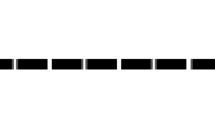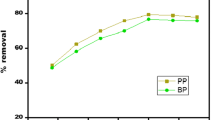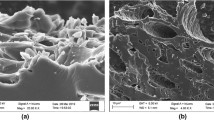Abstract
A methodology involving rice husk (RH), rice husk charcoal (RHC), and activated rice husk charcoal (ARHC) as an effective adsorbent to eliminate malachite green dye from aqueous solution using adsorption process by varying the pH, initial dye concentration (mg/L), contact time, temperature, and adsorbent doses (g/L). The surface characteristics were observed under scanning electron microscopy (SEM), and Fourier transform infrared (FTIR) spectroscopy was used to identify the chemical bonds present on the adsorbent surface. Data obtained from adsorption system at equilibrium condition were fitted to isotherm models such as Langmuir and Freundlich model where it was found that unlike raw RH and RHC equilibrium, data for ARHC fitted best to Langmuir model with 1000 mg/g as maximum adsorption capacity at 303 K, indicating homogeneous monolayer adsorption by the mesopores. The adsorption kinetics for all three adsorbents were observed to fit the pseudosecond-order model better. The negative value of ΔH and ΔS obtained from the thermodynamic study indicates that the process is exothermic and involves an associative mechanism respectively. Boyd plot was used to understand the mass transfer mechanism. Moreover, fixed-bed column studies were performed using ARHC as the adsorbent. At different experimental conditions such as inlet flow rate (Q), initial dye concentration (C0), bed height (Lb), and pH, it was observed that the adsorption capacity (kd*) of MG dye on ARHC in a fixed bed continuous flow in a column mode, ranged between 0.008 and 0.177 (g/g). Present investigation and comparison with other reported adsorbents concluded that RH, RHC, and ARHC can be used as efficient and environment-friendly adsorbents for the removal of dissolved malachite green from contaminated water. However, ARHC was proved to be the best-suited candidate among the three adsorbents.




Similar content being viewed by others
Data availability
Data will be provided on request.
7. References
Rajan MR DNS (2014) Impact of Dyeing Industry Effluent on Groundwater Quality by Water Quality Index and Correlation Analysis. J Pollut Eff Control 02: https://doi.org/10.4172/2375-4397.1000126
Culp SJ, Mellick PW, Trotter RW, et al (2006) Carcinogenicity of malachite green chloride and leucomalachite green in B6C3F1 mice and F344 rats. Food Chem Toxicol 44:. https://doi.org/10.1016/j.fct.2006.01.016
Nigam P, Banat IM, Singh D, Marchant R (1996) Microbial process for the decolorization of textile effluent containing azo, diazo and reactive dyes. Process Biochem 31:. https://doi.org/10.1016/0032-9592(95)00085-2
Ganguly P, Sarkhel R, Das P (2020) Synthesis of pyrolyzed biochar and its application for dye removal: Batch, kinetic and isotherm with linear and non-linear mathematical analysis. Surfaces and Interfaces 20:. https://doi.org/10.1016/j.surfin.2020.100616
Chakraborty V, Das P, Roy PK (2021) Graphene oxide–coated pyrolysed biochar from waste sawdust and its application for treatment of cadmium-containing solution: batch, fixed-bed column, regeneration, and mathematical modelling. Biomass Convers Biorefinery. https://doi.org/10.1007/s13399-020-01153-7
Dushenkov V, Kumar PBAN, Motto H, Raskin I (1995) Rhizofiltration: The Use of Plants to Remove Heavy Metals from Aqueous Streams. Environ Sci Technol 29:. https://doi.org/10.1021/es00005a015
Das L, Sengupta S, Das P, et al (2021) Experimental and Numerical modeling on dye adsorption using pyrolyzed mesoporous biochar in Batch and fixed-bed column reactor: Isotherm, Thermodynamics, Mass transfer, Kinetic analysis. Surfaces and Interfaces 23:. https://doi.org/10.1016/j.surfin.2021.100985
Periasamy K, Namasivayam C (1996) Removal of copper(II) by adsorption onto peanut hull carbon from water and copper plating industry wastewater. Chemosphere 32:. https://doi.org/10.1016/0045-6535(95)00332-0
Kalavathy MH, Karthikeyan T, Rajgopal S, Miranda LR (2005) Kinetic and isotherm studies of Cu(II) adsorption onto H3PO4-activated rubber wood sawdust. J Colloid Interface Sci 292:. https://doi.org/10.1016/j.jcis.2005.05.087
Badmus M, Audu T, Anyata B (2007) Removal of lead ion from industrial wastewaters by activated carbon prepared from periwinkle shells (Typanotonus fuscatus). Turkish J Eng Environ Sci 31:251–263
Madhavarao M, Ramesh A, Purnachandrarao G, Seshaiah K (2006) Removal of copper and cadmium from the aqueous solutions by activated carbon derived from Ceiba pentandra hulls. J Hazard Mater 129:. https://doi.org/10.1016/j.jhazmat.2005.08.018
Namasivayam C, Kadirvelu K (1997) Agricultural solid wastes for the removal of heavy metals: Adsorption of Cu(II) by coirpith carbon. Chemosphere 34:. https://doi.org/10.1016/S0045-6535(96)00384-0
Gidde MRJAP, Jivan AP (2007) Waste to Wealth, Potential of Rice Husk in India a Literature Review. In: International Conference on Cleaner Technologies and Environmental Management PEC. Pondicherry, pp 586–590
Zain MFM, Islam MN, Mahmud F, Jamil M (2011) Production of rice husk ash for use in concrete as a supplementary cementitious material. Constr Build Mater 25:. https://doi.org/10.1016/j.conbuildmat.2010.07.003
Imagawa A, Seto R, Nagaosa Y (2000) Adsorption of chlorinated hydrocarbons from air and aqueous solutions by carbonized rice husk. Carbon N Y 38:. https://doi.org/10.1016/S0008-6223(00)00006-3
Singh B (2018) Rice husk ash. In: Waste and supplementary cementitious materials in concrete: Characterisation, Properties and Applications. Elsevier, pp 417–460
Todkar BS, Deorukhkar OA, Deshmukh SM (2016) Extraction of Silica from Rice Husk. Int J Eng Res Dev 12:69–74
Khan EA, Shahjahan, Khan TA (2018) Adsorption of methyl red on activated carbon derived from custard apple ( Annona squamosa ) fruit shell: Equilibrium isotherm and kinetic studies. J Mol Liq 249:. https://doi.org/10.1016/j.molliq.2017.11.125
Das L, Das P, Bhowal A, Bhattachariee C (2020) Synthesis of hybrid hydrogel nano-polymer composite using Graphene oxide, Chitosan and PVA and its application in waste water treatment. Environ Technol Innov 18:. https://doi.org/10.1016/j.eti.2020.100664
Banerjee P, Das P, Zaman A, Das P (2016) Application of graphene oxide nanoplatelets for adsorption of Ibuprofen from aqueous solutions: Evaluation of process kinetics and thermodynamics. Process Saf Environ Prot 101:. https://doi.org/10.1016/j.psep.2016.01.021
Boyd GE, Adamson AW, Myers LS (1947) The exchange adsorption of ions from aqueous solutions by organic zeolites. II. Kinetics 1. J Am Chem Soc 69:. https://doi.org/10.1021/ja01203a066
Dotto GL, Buriol C, Pinto LAA (2014) Diffusional mass transfer model for the adsorption of food dyes on chitosan films. Chem Eng Res Des 92:. https://doi.org/10.1016/j.cherd.2014.03.013
Song W, Xu X, Tan X, et al (2015) Column adsorption of perchlorate by amine-crosslinked biopolymer based resin and its biological, chemical regeneration properties. Carbohydr Polym 115:. https://doi.org/10.1016/j.carbpol.2014.09.010
Tan KL, Hameed BH (2017) Insight into the adsorption kinetics models for the removal of contaminants from aqueous solutions. J Taiwan Inst Chem Eng 74:. https://doi.org/10.1016/j.jtice.2017.01.024
Dima JB, Ferrari M, Zaritzky N (2020) Mathematical modeling of fixed-bed columns adsorption: hexavalent chromium onto chitosan flakes. Ind Eng Chem Res 59:. https://doi.org/10.1021/acs.iecr.0c02004
Magga Z, Tzovolou DN, Theodoropoulou MA, et al (2008) Soil column experiments used as a means to assess transport, sorption, and biodegradation of pesticides in groundwater. J Environ Sci Heal Part B 43:. https://doi.org/10.1080/03601230802388868
Harmon TC, Ball WP, Roberts PV (2015) Nonequilibrium transport of organic contaminants in groundwater
Ali F, Bibi S, Ali N, et al (2020) Sorptive removal of malachite green dye by activated charcoal: Process optimization, kinetic, and thermodynamic evaluation. Case Stud Chem Environ Eng 2:. https://doi.org/10.1016/j.cscee.2020.100025
Sartape AS, Mandhare AM, Jadhav V V., et al (2017) Removal of malachite green dye from aqueous solution with adsorption technique using Limonia acidissima (wood apple) shell as low cost adsorbent. Arab J Chem 10:. https://doi.org/10.1016/j.arabjc.2013.12.019
Garg V., Kumar R, Gupta R (2004) Removal of malachite green dye from aqueous solution by adsorption using agro-industry waste: a case study of Prosopis cineraria. Dye Pigment 62:. https://doi.org/10.1016/j.dyepig.2003.10.016
Bao Y, Zhang G (2012) Study of adsorption characteristics of methylene blue onto activated carbon made by Salix Psammophila. Energy Procedia 16:. https://doi.org/10.1016/j.egypro.2012.01.182
Chowdhury S, Saha P (2010) Sea shell powder as a new adsorbent to remove Basic Green 4 (Malachite Green) from aqueous solutions: Equilibrium, kinetic and thermodynamic studies. Chem Eng J 164:. https://doi.org/10.1016/j.cej.2010.08.050
Chowdhury S, Chakraborty S, Saha P Das (2013) Response surface optimization of a dynamic dye adsorption process: a case study of crystal violet adsorption onto NaOH-modified rice husk. Environ Sci Pollut Res 20:. https://doi.org/10.1007/s11356-012-0989-7
Mohanty K, Naidu JT, Meikap BC, Biswas MN (2006) Removal of Crystal Violet from Wastewater by Activated Carbons Prepared from Rice Husk. Ind Eng Chem Res 45:. https://doi.org/10.1021/ie060257r
Sarkar M, Santra D (2015) Modeling fluoride adsorption on cerium-loaded cellulose bead—response surface methodology, equilibrium, and kinetic studies. Water, Air, Soil Pollut 226:. https://doi.org/10.1007/s11270-015-2307-8
Tan IAW, Hameed BH (2010) Adsorption isotherms, kinetics, thermodynamics and desorption studies of basic dye on activated carbon derived from oil palm empty fruit bunch. J Appl Sci 10:. https://doi.org/10.3923/jas.2010.2565.2571
Ahmad AA, Hameed BH (2010) Fixed-bed adsorption of reactive azo dye onto granular activated carbon prepared from waste. J Hazard Mater 175:. https://doi.org/10.1016/j.jhazmat.2009.10.003
Sha W, Wu X, Keong KG (2011) Modelling the thermodynamics and kinetics of crystallisation of nickel–phosphorus (Ni–P) deposits. In: Electroless Copper and Nickel–Phosphorus Plating. Elsevier
Yagub MT, Sen TK, Afroze S, Ang HM (2015) Fixed-bed dynamic column adsorption study of methylene blue (MB) onto pine cone. Desalin Water Treat 55:. https://doi.org/10.1080/19443994.2014.924034
Hema M, Martin P, Prasath D, Arivoli S (2009) Adsorption of malachite green onto carbon prepared from borassus bark. Arab J Sci Eng 34:
Guechi E-K, Hamdaoui O (2016) Sorption of malachite green from aqueous solution by potato peel: Kinetics and equilibrium modeling using non-linear analysis method. Arab J Chem 9:. https://doi.org/10.1016/j.arabjc.2011.05.011
Gupta N, Kushwaha AK, Chattopadhyaya MC (2016) Application of potato (Solanum tuberosum) plant wastes for the removal of methylene blue and malachite green dye from aqueous solution. Arab J Chem 9:. https://doi.org/10.1016/j.arabjc.2011.07.021
Khattri SD, Singh MK (2009) Removal of malachite green from dye wastewater using neem sawdust by adsorption. J Hazard Mater 167:. https://doi.org/10.1016/j.jhazmat.2009.01.101
Vasanth Kumar K, Sivanesan S (2007) Isotherms for Malachite Green onto rubber wood (Hevea brasiliensis) sawdust: Comparison of linear and non-linear methods. Dye Pigment 72:. https://doi.org/10.1016/j.dyepig.2005.07.021
Mall ID, Srivastava VC, Agarwal NK, Mishra IM (2005) Adsorptive removal of malachite green dye from aqueous solution by bagasse fly ash and activated carbon-kinetic study and equilibrium isotherm analyses. Colloids Surfaces A Physicochem Eng Asp 264:. https://doi.org/10.1016/j.colsurfa.2005.03.027
Pradeep Sekhar C, Kalidhasan S, Rajesh V, Rajesh N (2009) Bio-polymer adsorbent for the removal of malachite green from aqueous solution. Chemosphere 77. https://doi.org/10.1016/j.chemosphere.2009.07.068
Acknowledgements
The authors wish to thank the Dalmia Holding Groups for the financial support and also thankful to the Dept. of Chemical Engineering, Jadavpur University, for their great facilities and support.
Funding
The authors wish to thank the Dalmia Holding Groups for the financial support.
Author information
Authors and Affiliations
Contributions
NS had done all the experimental work and preparing the manuscript; LD also prepared the manuscript; and PD, AB, and CB supervised the work.
Corresponding author
Ethics declarations
Conflict of interest
The authors declare no competing interests.
Additional information
Publisherʼs note
Springer Nature remains neutral with regard to jurisdictional claims in published maps and institutional affiliations.
Rights and permissions
About this article
Cite this article
Saha, N., Das, L., Das, P. et al. Comparative experimental and mathematical analysis on removal of dye using raw rice husk, rice husk charcoal and activated rice husk charcoal: batch, fixed-bed column, and mathematical modeling. Biomass Conv. Bioref. 13, 11023–11040 (2023). https://doi.org/10.1007/s13399-021-01996-8
Received:
Revised:
Accepted:
Published:
Issue Date:
DOI: https://doi.org/10.1007/s13399-021-01996-8




